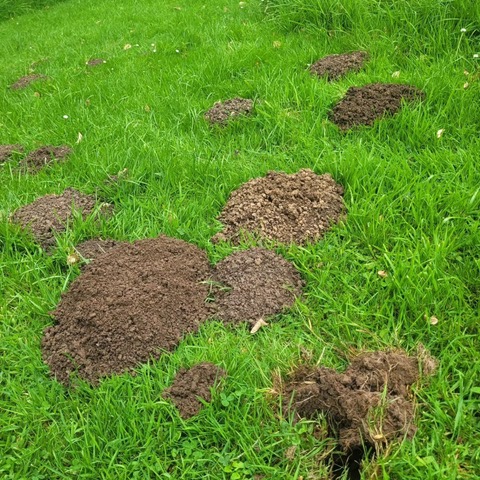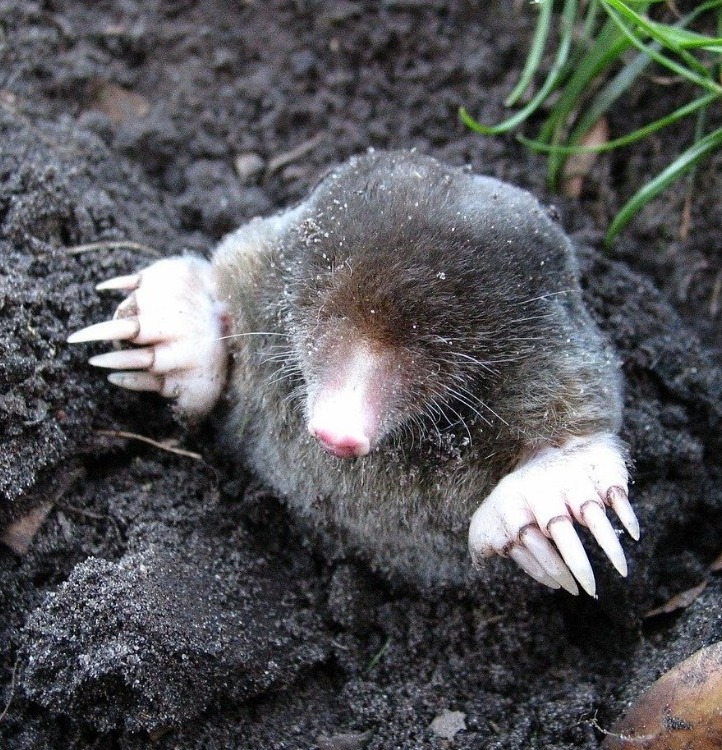Have moles turned your beautiful yard and garden into a frustrating landscape thanks to their persistent burrowing and tunneling? Mole activity can wreak havoc on your carefully nurtured plants and lawn.
So, if you’re tired of dealing with these elusive critters, it is time to put in the work to get rid of them.
Let this comprehensive guide help you regain control of your outdoor space. Learn how to get rid of moles in yard and garden and restore your yard to its former glory, free from mole-induced woes.
What Are Moles?
Moles are tiny, burrowing mammals renowned for their distinctive physical features. These features include cylindrical bodies, short legs with powerful digging claws, and eyes that are typically small and hidden under fur.
These insectivores are superbly adapted for a subterranean lifestyle, navigating through their underground tunnels using their keen sense of touch and smell.
As all living things must feed to survive, what do moles eat? Moles diet mainly consists of insects, grubs, and earthworms, which they locate by detecting vibrations and movements in the soil. These little mammals consume about half their body weight daily to survive.
As voracious diggers, moles create complex networks of tunnels, which are both beneficial (aerating the soil and controlling pest populations) and detrimental (damaging roots and disrupting garden landscapes) to human environments.
Despite their seemingly pesky behavior in yards and gardens, moles play a crucial role in maintaining soil health and ecological balance. However, they can also be disruptive, so don’t ignore their presence.
Related Posts:
- How To Get Rid Of Voles In Your Yard Naturally
- What Animal Is Digging Holes In My Yard
- How to get rid of gophers with castor oil and dish soap
What Attracts Moles To Your Yard?
Check out these tell-tale signs of a mole infestation in your yard.
a) Abundance of Food
Plenty of food, mainly insects, grubs, and earthworms, will atract moles to your yard. Healthy soil ecosystems can support a diverse population of insects and grubs, giving moles a steady food supply.
Your yard will have many earthworms if it has moist soil and organic matter. Lawn pests like grubs or larvae of beetles are also a delicacy for moles, and their presence can draw moles into your garden. Moreover, your vegetable and flower gardens can harbor a variety of insects and larvae that moles eat.
b) Moisture
Moles prefer environments with damp soil because it’s softer and easier to dig through. Also, since many insects prefer moist areas, moles will have plenty to eat. Waterlogged spaces created by poor drainage can force insects and earthworms closer to the surface, making them more accessible to the moles.
Moles will also likely visit your yard during dry seasons in search of water-rich areas if you have automatic sprinkler systems or garden hoses.
c) Loose Soil
Moles will choose a yard with loose friable soil over one with compact soil as it is easier to burrow through since it offers less resistance. Loose soil can also harbor a larger population of insects, grubs, and earthworms, moles’ primary food source.
Furthermore, moles create nesting chambers and sheltered areas to raise their young and protect themselves from predators in loose soil.
Read more:
- How To Get Rid Of Rats In Garden
- How To Get Rid Of Slugs And Snails In Garden Naturally
- How To Get Rid Of Skunks
d) Mulch and Compost
While moles don’t eat compost and mulch, they attract insects that these mammals love to eat. Mulch and compost provide an organic, nutrient-rich environment that promotes the growth of beneficial microorganisms and attracts insects such as beetles and grubs.
Mulch also helps create a moist environment, perfect for mole activity. Incorporating compost into your yard soil also improves its structure and aeration, making it more attractive to moles for tunneling and foraging. In addition, insects and small creatures that moles prey on get cover and shelter from compost and mulch.
e) Quiet and Undisturbed Areas
Since moles are sensitive to vibrations and disturbances, a quiet environment without constant disruptions is conducive. This allows them to carry out their tunneling and foraging activities.
Since moles rely heavily on their sense of touch to navigate through the soil, quiet areas with minimal human or animal activity result in fewer ground vibrations, making moles feel safer and more comfortable.
Moles will also focus on finding food efficiently in a tranquil yard free from constant disturbances.
f) Proximity to Natural Habitats
Moles’ natural habitats typically include fields, meadows, woodlands, and other areas with loose, moist soil rich in insects. Therefore, moles can easily explore and expand their territories into your property if your yard is close to natural habitats that already support their populations.
g) Lack of Predators
Moles will feel safe and less stressed in your yard if the risk of being eaten by their predators is low. These predators include some mammals, snakes, and hawks.
Read More: Best Home Remedies To Get Rid Of Bugs On Houseplants
7 Ways to Get Rid of Moles In Yard and Garden
Now that you know what moles are and what attracts them to your yards, let’s shift your focus to eliminating them.
1. Apply Natural Repellents
If you are not looking to kill or trap moles, deter them using natural repellents. The options available include castor oil-based repellent, garlic and chili pepper, elderberry plants, narcissus bulbs, mole plant, and ultrasonic devices.
You can also make your own homemade mole repellent by mixing castor oil, dawn soap and water and spraying it in the yard creates an odor and taste that moles find unpleasant.
The strong smell and taste of a mixture of crushed garlic and chili pepper flakes also repel moles. Additionally, the roots and leaves of elderberry plants produce toxins that moles dislike, so consider planting elderberry shrubs around your yard.
You can also plant daffodils and mole plant to deter moles. Moles will also find the high-frequency sound waves of ultrasonic devices unpleasant.
2. Use Humane Mole Traps
Moles don’t need to die to vacate your yard, as humane mole traps are available and affordable. Use a humane trap to capture and relocate moles to a more suitable environment. Mole-friendly traps come in the form of live-catch traps, bucket traps, and tunnel traps.
Bucket traps are homemade traps that use a bucket or container partially buried in the ground with ramps leading to the top. On the other hand, tunnel traps are placed inside mole tunnels and capture the mole as it passes through.
3. Install Barriers
Protect your garden beds and plant roots using underground barriers made of mesh or hardware cloth. This proactive approach creates physical obstacles that deter moles from tunneling into specific spaces.
A durable material like galvanized steel mesh or hardware cloth with small openings (1/4 inch or less) will prevent moles from squeezing through. Also, keep them from climbing or digging around it by curving the barrier outward at the top to create an “L” shape.
4. Reduce Moisture
Since moles love a damp environment, controlling your yard’s moisture levels is in your best interest. Therefore, correct any areas where water pools and redirect rainwater away from the yard using trenches or French drains to improve drainage. Also, water your plants and lawn only as needed to avoid overwatering.
In addition, don’t use too much mulch, fix any leaking pipes or irrigation systems, amend heavy clay soils with organic matter, raise your garden beds, and aerate the soil regularly.
5. Get rid of Insects
Considering how essential insects are to a mole’s diet, you must deal with the insect population in your yard. Attract natural predators of insects to your yard, such as birds (like robins and bluebirds), bats, and beneficial insects (like ladybugs and praying mantises).
Additionally, maintain healthy soil with proper nutrient levels and organic matter to support helpful microorganisms that help control pest populations.
Other ways to keep insects at bay are plant deterrents, protecting vulnerable plants with physical barriers, and biological control. Also, adopt an Integrated Pest Management approach, remove attractants like fallen fruits and vegetables, and use organic pesticides.
6. Predator Attractants
Birds of prey, snakes (like garter snakes and black snakes), domestic pets, and barn owls can also help you control the mole population, so encourage them to your yard.
Install nesting boxes or perches to entice raptors such as owls and hawks to frequent your yard. Create snake-friendly habitats using rock piles, logs, and shrubbery.
7. Proper Yard Maintenance
There are a plethora of things you can perform in your yard to make it less attractive to moles. These include:
- Tunnel Inspection: Regularly inspect your yard for mole activity, such as raised tunnels or molehills. Identifying active tunnels allows you to target deterrent measures in those areas.
- Address Molehills: If you notice fresh molehills, level them out to reduce the attractiveness of your yard to moles. Flattening molehills can make it less appealing for moles to return.
- Repair Damage: If you observe signs of mole damage, such as disturbed plant roots or uprooted plants, repair the affected areas promptly to prevent further harm.
- Prune Plants: Regularly trim and prune your plants to prevent dense, overgrown areas that might attract insects and offer hiding spots for moles.
- Weed Control: Regularly weed your garden beds to reduce hiding places for insects and limit their population.
- Mow Your Grass: cut the grass and keep your garden bed manicured.
Staying attentive to the condition of your landscape ensures you address mole-related issues promptly and implement preventive measures.
Final Remarks
Moles may be beneficial to your yard, helping with soil aeration, pest control, nutrient cycling, ecosystem balance, and biodiversity support. However, it’s time to get rid of them when their tunneling and foraging activities cause extensive damage to your yard.

I’m Mike Hyle, an exterminator with 7+ years of experience handling all sorts of pests, including mice, cockroaches, bed bugs, and termites. I also write for Pest Solutions DIY blog to share my knowledge and help homeowners keep their homes pest-free. Outside work, I enjoy hunting, snowshoeing, and exploring nature. Check out my blog for helpful pest control tips!



